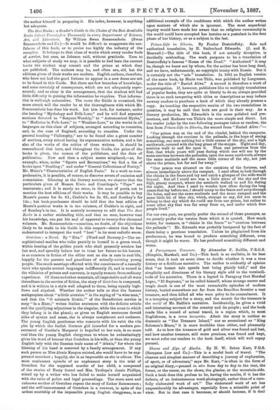Shores and Alps of Alaska. By H. W. Seton Karr,
F.G.S. (Sampson Low and Co.)—This is a model book of travel. "The clearest and simplest manner of describing a journey of exploration, of sport, or of adventure," says Mr. Karr, " is often in the form of an original diary,—penned in situ from day to day in the tent, the forest, or the canoe, on the shore, the glacier, or the mountain-side. Such a book does this profess to be, having the merits, if it has the defects, of an instantaneous word-photograph, rather than of a care- fully elaborated work of art." The elaborated work of art has unquestionably its advantages, especially from a scientific point of view. But in that case it becomes, or should become, if it deal
with a new or unexplored country, a work of science. For the ordinary reader who desires above all things bright and vivid description, the word-photograph is undoubtedly the beet. And Mr. Karr, albeit he 'wields a facile pen, neither indulges in line- writing nor strives after effect. One of the most interesting bits of description in the book is that of the attempted ascent of Mount Saint Elias, nearly twenty thousand feet above sea-level, the still unconquered peak of Alaska. Had the weather remained clear, the adventure might have been crowned with success. The author and his party were unfortunately compelled to beat a retreat after reaching an altitude of 7,200 ft., lees than half the altitude of Mont Blano. But the difficulties of an alpine ascent cannot he estimated in feet, and Mr. Kerr really reached a greater height over the summer snow-level than is possible in Europe, the snow-level on Mount Saint Elias being only four hundred feet above the sea-level, owing to the heavy annual snowfall. One of the most remarkable chapters in the book is the one entitled "Life with the Indians on the Copper River." It is the diary of John Bremner, the only white man who has ever lived among the Copper Indians, which by a happy chance came into Mr. Barr's possession. The intrepid prospector joined the Allen expedition in the spring of 1885, and after wintering on the Copper River, descended the Yukon River. Mr. Karr wisely gives the narrative as be found it, "phonetically spelt and un- punctuated, but laconic, forcible, and unencumbered with redundant verbiage." It ions good as anything in " Robinson Came." Travel in Alaska is no child's-play, and should be undertaken by none who are not prepared to carry their lives in their hands. More than once our author narrowly escaped violent death. Shortly before he left the country, one of his companions was shot dead by his side, and another severely wounded, as they sat together at supper ; and the voyage from Kodiak Inland to San Francisco with a drunken mad captain, in weather so stormy that the schooner lay hove to for two nights, must have been as trying for the nerves as a pitched battle, and probably twice as dangerous. In addition to its other good qualities, Shores and Alps of Alaska is profusely and admirably illus- trated, furnished with two maps, and a copious index. It is a book which ought to be read, and deserves to be kept.



















































 Previous page
Previous page